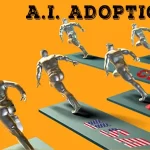Adaptive Learning is a technologically-driven personalized learning experience. This model incorporates algorithms, assessments, and feedback to tailor unique learning paths and course sequencing to suit various learning styles.
Traditional teaching presents a rigid course material to fit all the students. Adaptive Learning makes use of frequent assessments, exchanges feedback with learners, and opens alternative learning paths that help students gain content mastery before moving onto other steps of learning.
Case Study
Let us say a group of 5 students are undertaking a module which includes sections such as Logical Reasoning, Quantitative Aptitude, Statistics and Language skills. If the teacher applies conventional methodology, he will hand out course material and then evaluate the students through tests. The learning outcomes are understandably poor. The teacher finds that among the 5, one is especially conversant in language skills while being weak in statistics. He may find still others who are well versed in all the sections of the module.
Yet the common evaluation generates an average result for all five, which is as good as false data. Going by this data, some students fail in select sections, some excel in all, while others move on with insufficient depth of knowledge in a section where they had begun to show promise.
Problems with the Case Study
The concerns regarding with the aforementioned case study are evident.
- Sample Size: While monitoring a small group of 5 students, the teacher is able to alter the course depending on the areas which each student seems to struggle with. This option however limits itself to a small sample size. The teacher cannot single-handedly design unique learning pathways for say, a batch of 100 students.
- Inequitable teaching outcome: This method only pools the knowledge shared in the classroom to a handful of average students, while the high-performing students and those who fall behind get left out of the equation.
- False data: A “one-fits-all” evaluation technique for learners with differing abilities generates false data, leading to failing the term or causing drop-outs.
Adaptive Learning as a Ready Solution
Adaptive Learning addresses all these problems. It offers interactive systems that measure performances of each student. Additionally, based on similarity of demographic or ability, they offer customized learning paths and course materials.
Students communicate with programs, provide feedback, and complete quizzes – all of which helps the system learn or adapt to their unique learning style. This also presents content in a set sequence, adjusting to the students’ learning path and pace. Adaptive learning systems take on the task of restructuring the course sequence from the teacher. Consequently, we can apply it to a greater sample size with ease.
Traditional classroom teaching does not rule out certain drawbacks such as failure to clear assignments and drop-outs, which Adaptive Learning does help with.
School systems have been infamous for “teaching to the middle”, where there are no provisions to encourage excellent performers with more challenging material, or support lagging students with customized content. This leads to failing the classes or dropping out of the system.
This methodology ensures that students gain mastery over individual topics before moving on to the next. It also generates assessments based on the performance of the learners, caters to the under-performers, and bolsters the excellent students, with more complex tasks.
Benefits of Adaptive Learning
Adaptive Learning has three-fold advantages for students, teachers, and institutions as illustrated by the chart:

Challenges of Adaptive Learning
- Costly and Time-consuming: Adaptive Learning systems come at a steep cost to institutions. However, in most cases, it is a one-time investment. It also requires content-mapping and objective designing to support diverse learning styles and stages of mastery. This is a strenuous and time-consuming task.
- Not suited for some courses: Adaptive Learning is typically unsuited for courses that demand high-level critical thinking and evaluation.
- Not immediately effective: System algorithms need time to adapt to students’ learning needs by way of prolonged feedback and interaction. Systems also collect course materials over time before suggesting learning paths, so Adaptive Learning cannot be effective immediately.
Adaptive Course Samples
The great thing about Adaptive Learning system is that it can be applied to all levels of learning. Let’s look at some popular adaptive platforms and find out about sample course-ware.
- Quizalize is an adaptive platform which breaks down difficult concepts into fun, interactive quizzes. It promotes gamification in learning, and even allows for tracking students’ progress.
- Fulcrum Labs incorporates A.I to model a personal instructor for every learner who signs up. This platform takes the help of Artificial Intelligence, not only to track progress but also to make predictions about weak points and errors. It extends beyond academic subjects and helps students to cultivate real-world skills as well
- Elevate supports adult learning while entertaining learners at the same time. The platform includes a host of games, quizzes and alternate learning arcs to help adults improve upon math, reading, writing and speaking abilities. An added advantage of Elevate is that it is backed by significant research.
Taking a tour through these websites and looking at their course descriptions reveals how Adaptive Learning encourages students to choose their own path in online learning. In all these platforms we see how systems depend heavily on feedback, interaction and adaptation to learners and instructors as is the essential feature of this model.
In conclusion, Adaptive Learning though uniquely tailored for all learning needs, has its own limitations as well. By implementing it correctly, teachers hold the capability to maximize its benefits. We shall explain the different kinds of Adaptive Learning in this (placeholder) article.
For more information, visit Evelyn Learning blog.
Create. Engage. Inspire.

















